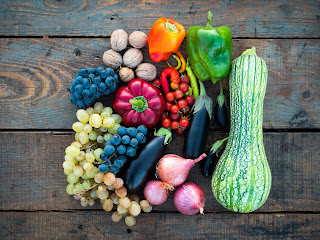Harmony
On June 26th, I and several other sustainability
employees took an overnight trip to Suzanne Hansen’s farm to visit Luther
College and learn more about their sustainable practices. We also visited one
of Suzanne’s neighbors, Marty, who is part of Macalester’s farm-to-fork program,
to see how some of the food Mac students eat is produced.
First, we went to Luther College and met with Toby Cain,
their Sustainability Coordinator. She and her student workers were incredibly
friendly and informative, spending the first few minutes getting to know us a
bit before answering our questions. We learned that one of Luther’s goals is a 70% reduction in its carbon footprint by
2020, an ambitious target that they are on track to hit. Toby told us that they
are already at nearly 54%, but it didn’t come in the way they’d expected.
Initially, Luther assumed that energy efficiency would be a minor factor in
their reduction efforts. However, their investments in efficiency alone brought
them all the way to 40% of their footprint reduction. Luther also has the good fortune to have
plenty of space to implement renewable energy sources. It’s location in the
small town of Decorah, Iowa allowed the college to install a wind turbine that
now provides about one third of all the electricity used on campus.
When I asked the other Mac students what their favorite parts
of our trip were, Miriam Eide (’20) answered that learning about the “renewable
energy progress made by Luther” was at the top of her list, tied with their
attention to food justice. One of Toby’s student workers told us about the free
food pantry available 24/7 to any student who needs it. Additionally, they
maintain two edible landscapes (fenced in only to prevent animal herbivory),
where anyone is welcome to walk and taste the many vegetables and leafy greens
growing freely. Toby took us out to one of the landscapes and picked leaves
right off the plants for us to try, sharing the names of the plants and some of
the ways they could be incorporated into meals. We even tried some ‘weeds’ that
were growing wild between the rows (they were delicious)! After that, we drove
out to the full acre of garden land maintained by Luther that’s used to produce
veggies for their dining service. Some plots are even given to the faculty and
staff to raise personal gardens.
After saying goodbye to Toby and her students, Suzanne
directed us to the nearby Seed Savers Exchange. We walked through their
gardens, pet their chickens, and looked for the baby cow they told us was
roaming around, with no success. Lauren Webber’s (’20) favorite moment from the
trip was enjoying the gardens, and she said they made her “want to eat kale for
the rest of [her] days.” As for myself, I bought some Chamomile seeds that are
already starting to sprout.
After Seed Savers, it was time to go home and get dinner
ready. Suzanne’s farm is a rustic and inviting place, with a composting toilet
and hand-drawn water from her well. After a dinner of grilled veggies with rice
and beans, we went to bed, the student workers sharing a tent in the back yard.
Milly Cogen (’21) and I woke up at 2am for my personal favorite part of the
trip: stargazing. The overwhelming number of stars reflected by hundreds of
fireflies was dizzying, but stunning.
The next morning, the only thing on our agenda was visiting
Marty’s farm. He and his family are part of a gorgeous Amish community and
raise beef and produce for Bon Appetit. Milly’s favorite experience was
learning more about the benefits of buying local food. Marty explained that
everything grown on his farm is certified organic, and no pesticides are used
beyond the occasional spray of a vegetable mixture. Additionally, selling
locally means that Marty doesn’t have to worry about how soon his produce
ripens after harvesting. He explained that produce travelling across the country
must ripen on the delivery truck.
Unfortunately, we didn’t have time to stay more than an hour
or two, but Marty made sure we got the most out of our visit. We met his
chickens and children, saw his impressive line of handmade furniture, and visited
his father’s farm in that short time. On our way home, we stopped to pick up a
shipment of meat that Marty needed delivered to Bon Appetit. The irony of a van
full of vegetarians delivering meat was not lost on any of us.


Comments
Post a Comment